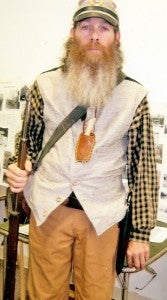Education essential part of rural Polk County history
Published 9:27 am Friday, October 4, 2013
Hats off to Krista Haynes and the hundreds of wonderful volunteers who, once again, made this year’s Green Creek Heritage Festival

Green Creek resident, Thomas White, grew a beard and wore a Confederate soldiers uniform when he visited the history room at the Green Creek Heritage Festival. (photo submitted)
so successful.
Each year, I’m amazed as activities continue to flow smoothly throughout the day. The numerous hours of planning and the hard work of this dedicated team of volunteers is exceptional.
Every year at the Green Creek Heritage Festival, I learn new things about Polk County’s past from people who visit the history room there.
Did you know that in rural Polk County, education in the early public schools was available only to those people who lived close enough to walk to a school building? There were no school buses picking up students in our area until about 1925, and students had to walk to the one- and two-room schoolhouses in their area. These small schools were usually 2 to 3 miles apart, and were only open about three months a year. Sometimes, first grade children had to walk to those schools alone.
Hillcrest Institute, a much- loved mission school in Sandy Plains, helped to change things in this area. Hillcrest was very different from the public schools that had existed before it was built.



